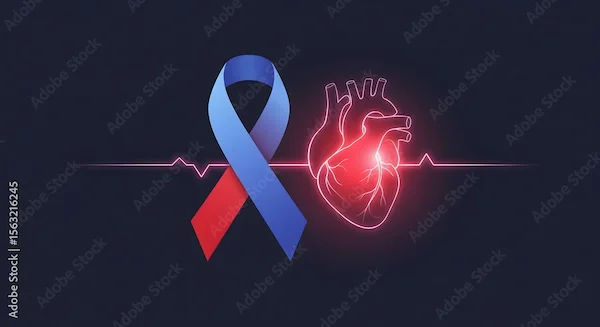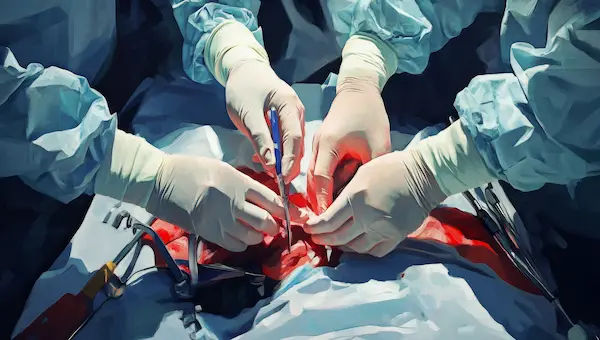Heart Failure Vs. Heart Attack: Key Differences You Should Know
Understand the difference between heart failure and a heart attack. Learn about their causes, symptoms, and treatment options to take charge of your heart health effectively.

Written by Dr Sonia Bhatt
Last updated on 3rd Jul, 2025
Heart disease is recognised as the leading cause of death worldwide. While heart failure and heart attacks are related, they are not the same. People often confuse these terms and use them interchangeably. Although heart failure and heart attack are both types of heart disease with some shared causes but distinct differences. Let’s explore the differences between heart failure and a heart attack in this blog.
What is Heart Failure?
Heart failure, also known as congestive heart failure, is a chronic condition that occurs when the heart muscles are unable to pump enough blood to meet the body's needs. Narrowed coronary arteries and high blood pressure can weaken, block, or stiffen the heart, leading to improper blood flow. Unlike a sudden event, heart failure typically develops gradually over time.
1. Causes and Risk Factors of Heart Failure
The key causes of heart failure are as follows:
Coronary Artery Disease (CAD): The most common form of heart disease. Cholesterol and fatty deposits build up in the coronary arteries, reducing blood flow to the heart muscle. This can lead to chest pain (angina) and, over time, heart failure.
History of Heart Attack (Myocardial Infarction): A previous heart attack can damage the heart muscle, impairing its ability to pump blood efficiently.
High Blood Pressure (Hypertension): Uncontrolled high blood pressure forces the heart to work harder to circulate blood, eventually weakening the heart muscle and causing heart failure.
Abnormal Heart Valves: Congenital defects, infections, or other heart diseases can prevent valves from opening or closing properly. This forces the heart to work harder, increasing the risk of heart failure.
Heart Muscle Disease (Cardiomyopathy): Conditions like dilated cardiomyopathy, hypertrophic cardiomyopathy, or myocarditis (inflammation) caused by infections, alcohol, or drug use can damage the heart muscle, leading to heart failure.
Congenital Heart Disease: Birth defects in the heart or its chambers can overburden the healthy parts of the heart, raising the likelihood of heart failure.
Lung Disease: Severe lung diseases force the heart to work harder to deliver oxygen-rich blood to the body, potentially causing heart failure.
Diabetes: Diabetes increases the risk of hypertension and atherosclerosis, which can lead to heart failure.
Obesity: Obesity strains the heart by requiring it to work harder. Conditions like sleep apnea and cardiomyopathy associated with obesity can also contribute to heart failure.
2. Symptoms of Heart Failure
Symptoms of heart failure can develop gradually or appear suddenly. Common signs and symptoms of heart failure include:
Shortness of breath during physical activity or while lying down
Fatigue and a general feeling of weakness
Swelling in the legs, ankles, or feet
Rapid or irregular heartbeat
Decreased ability to perform physical activities
Wheezing or difficulty breathing
Persistent cough, which may produce white or pink mucus, sometimes tinged with blood
Abdominal swelling or bloating
Sudden weight gain due to fluid retention
Nausea and loss of appetite
Trouble concentrating or feeling mentally less alert
Chest pain, particularly if heart failure results from a heart attack
What is a Heart Attack?
A heart attack, also known as a myocardial infarction, occurs when blood flow and oxygen supply to the heart are blocked. Over time, fatty deposits containing cholesterol accumulate in the arteries, forming plaques. If a plaque ruptures, it can lead to the formation of a blood clot. This clot may block the artery, cutting off blood flow to the heart. Without adequate blood supply, the affected heart muscle tissue begins to die, resulting in a heart attack.
1. Causes and Risk Factors of Heart Attack
A heart attack occurs when blood flow to the heart muscle is blocked. The primary causes of these blockages include:
Atherosclerosis: Plaque buildup in the coronary arteries narrows them. Ruptured plaques can lead to blood clots, completely blocking blood flow.
Coronary Artery Spasm: Sudden narrowing or stiffening of a coronary artery, often triggered by smoking, cold weather, or extreme stress.
Coronary Artery Dissection: Separation of the inner wall of a coronary artery, which disrupts blood flow to the heart muscle.
Obesity: Increases the risk of atherosclerosis and contributes to other risk factors like hypertension and diabetes.
Smoking and Unhealthy Lifestyle: Smoking damages blood vessels and promotes plaque buildup, while poor lifestyle habits exacerbate other risk factors.
2. Symptoms of Heart Attack
Heart attack symptoms can vary widely. Some individuals experience mild symptoms, others have severe symptoms, and some may not notice any symptoms at all. Some of the common symptoms of heart attack are as follows:
Chest pain or discomfort, often described as pressure, tightness, squeezing, aching, or pain
Pain or discomfort that radiates to the shoulders, arms, back, neck, jaw, teeth, or occasionally the upper abdomen
Cold sweats
Unusual fatigue
Feelings of heartburn or indigestion
Lightheadedness or sudden dizziness
Nausea
Shortness of breath
If you experience any of these symptoms, seek immediate medical attention, as timely treatment can save lives.
Diagnostic Techniques
Diagnosing both heart failure and heart attack requires a comprehensive approach, as both conditions involve the heart but present with distinct causes and symptoms. Identifying these conditions early ensures better management and improved outcomes for patients.
To diagnose heart failure and heart attack, a variety of tests may be performed to assess the heart's condition and determine the cause of the symptoms. These tests can include:
Blood Tests: These help identify underlying conditions that may affect the heart and measure specific proteins released by the heart and blood vessels.
Chest X-ray: X-rays provide images of the heart and lungs, revealing fluid buildup or changes in the heart's size and shape.
Electrocardiogram (ECG or EKG): A painless test that records the electrical signals of the heart, showing its rhythm and rate, which can indicate abnormalities.
Echocardiogram: This imaging test uses sound waves to create real-time images of the heart, showing the size, structure, and function of the heart and valves, as well as blood flow.
Ejection Fraction: Measured during an echocardiogram, this test determines the percentage of blood pumped out of the heart with each beat. A low ejection fraction can help classify heart failure and guide treatment.
Exercise or Stress Tests: These tests assess the heart's response to physical activity, either by walking on a treadmill or using medications if exercise is not possible.
CT Scan of the Heart: A cardiac CT scan uses X-rays to create detailed cross-sectional images of the heart.
Heart MRI (Cardiac MRI): This test uses magnetic fields and radio waves to produce high-resolution images of the heart, providing insights into its structure and function.
Coronary Angiogram: A catheter is inserted into a blood vessel and guided to the heart to inject dye, which makes blockages in the coronary arteries visible on X-ray images.
Myocardial Biopsy: In this procedure, small samples of the heart muscle are taken for examination to diagnose certain heart muscle diseases that may contribute to heart failure.
Treatment Options for Heart Failure and Heart Attack
Heart failure and heart attacks require distinct treatment approaches. Understanding the available options for each condition can help manage symptoms, improve heart function, and reduce long-term risks.
1. Heart Failure
Managing heart failure requires lifelong treatment. With consistent care, symptoms can improve, and the heart muscle may become stronger. The primary treatment options include:
Medications:
To lower blood pressure
To normalise heart rhythm
To reduce swelling (oedema)
To manage breathing difficulties
Surgical and Device-Based Interventions:
Coronary Artery Bypass Surgery: Restores blood flow by bypassing blocked arteries.
Heart Valve Repair or Replacement: Corrects malfunctioning valves to ensure proper blood flow.
Implantable Cardioverter-Defibrillators (ICDs): Devices implanted to regulate abnormal heart rhythms.
Cardiac Resynchronisation Therapy (CRT): Also called biventricular pacing, this device ensures the heart pumps blood efficiently.
Heart Transplant: For severe heart failure unresponsive to other treatments, a heart transplant may be the only option.
2. Heart Attack
A heart attack is a medical emergency requiring immediate attention to restore blood flow and minimise heart damage. Treatment options include:
Medications:
To prevent blood clots and restore blood flow.
To lower and control cholesterol levels and blood pressure.
To manage stress and anxiety.
Surgical Procedures:
Coronary Angioplasty and Stenting: Also known as percutaneous coronary intervention (PCI). This procedure removes blockages, restores blood flow, and places a stent to keep the artery open.
Coronary Artery Bypass Surgery: Can be performed as an emergency procedure during a heart attack or scheduled after stabilisation. It involves rerouting blood flow around blocked arteries to restore circulation.
Lifestyle Changes and Prevention
Adopting healthy lifestyle habits can significantly reduce the risk of heart failure and heart attack while also helping manage these conditions effectively.
Healthy Diet: Consume a heart-healthy diet rich in fruits, vegetables, whole grains, lean proteins, and healthy fats.
Regular Exercise: Engage in moderate physical activities like walking, swimming, or cycling for at least 30 minutes regularly.
Quit Smoking and Limit Alcohol: Avoid tobacco products, exposure to secondhand smoke and alcohol intake.
Manage Stress: Practice stress-relief techniques such as yoga, meditation, or deep breathing.
Monitor Health Conditions: Regularly check and control blood pressure, cholesterol, and blood sugar levels.
Understand Risk Factors: Know your family history and discuss it with your healthcare provider to understand your risk of heart disease.
Take Medications as Prescribed: If there are existing conditions such as hypertension, diabetes, or high cholesterol, take prescribed medications consistently.
Conclusion
Heart failure and heart attack are distinct yet interconnected conditions that significantly impact heart health. Understanding their differences, causes, symptoms, diagnostic methods, and treatment options is crucial for effective management and prevention. While heart failure is a chronic condition that develops over time, a heart attack is a medical emergency requiring immediate intervention. By making informed lifestyle choices, seeking timely medical attention, and adhering to prescribed treatments, individuals can significantly reduce the risks and complications associated with both conditions.
Consult Top Cardiologist
Consult Top Cardiologist

Dr. Anand Ravi
General Physician
2 Years • MBBS
Bengaluru
PRESTIGE SHANTHINIKETAN - SOCIETY CLINIC, Bengaluru
Dr Moytree Baruah
Cardiologist
10 Years • MBBS, PGDCC
Guwahati
Apollo Clinic Guwahati, Assam, Guwahati

Dr. Zulkarnain
General Physician
2 Years • MBBS, PGDM, FFM
Bengaluru
PRESTIGE SHANTHINIKETAN - SOCIETY CLINIC, Bengaluru

Dr Nazneen Khan
Cardiologist
7 Years • M.B.B.S, M.D (MEDICINE), DrNB CARDIOLOGY
Pune
Apollo Clinic, Viman Nagar, Pune

Dr. Janjirala Seshivardhan
Cardiologist
7 Years • MBBS,DNB(GM),DM(Cardiology)
Manikonda Jagir
Apollo Clinic, Manikonda, Manikonda Jagir



.webp)
